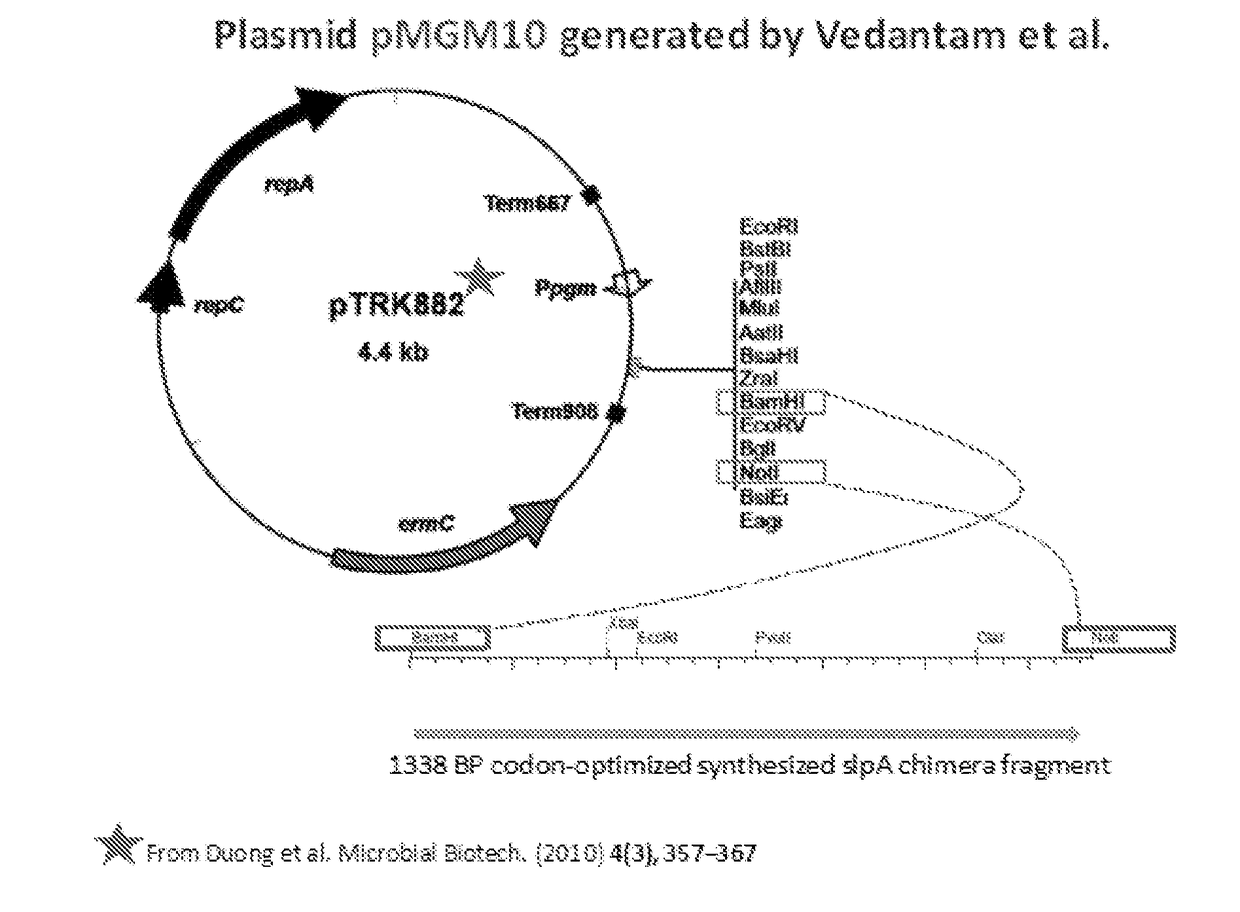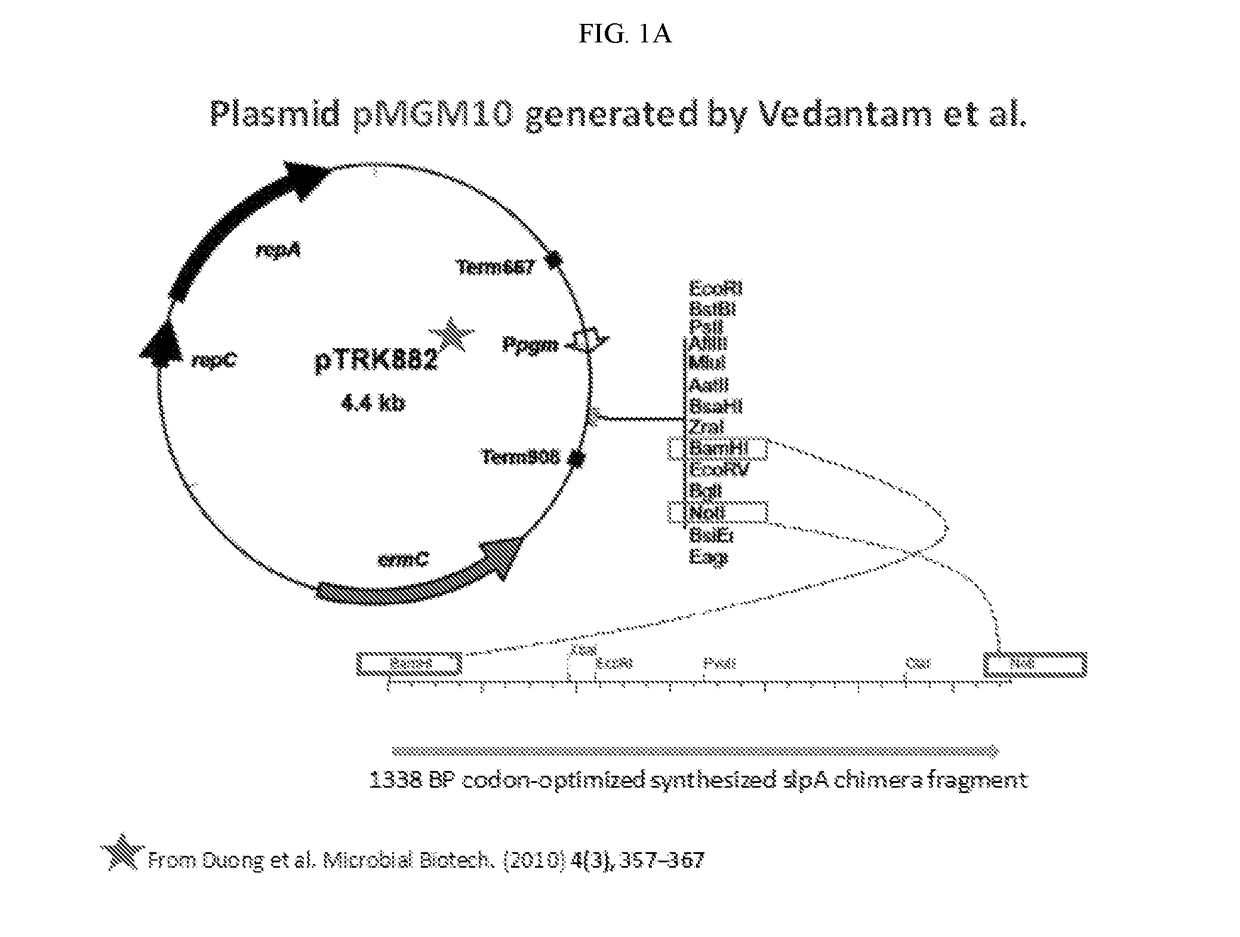Compositions comprising recombinant probiotic bacteria and methods of use thereof
a technology of probiotic bacteria and recombinant bacteria, which is applied in the field of compositions comprising recombinant probiotic bacteria, can solve the problems of imposing over $3 billion in healthcare-associated costs, lack of effective treatment and preventatives for i>clostridium difficile /i>infection and colonization, and inability to protect against i>c. difficile /i>colonization, etc., and achieves the effect of facilitating
- Summary
- Abstract
- Description
- Claims
- Application Information
AI Technical Summary
Benefits of technology
Problems solved by technology
Method used
Image
Examples
example 1
Bacterial Strains Expressing Chimeric SlpA are Effective at Gut Colonization and Protecting Against C. difficile Challenge
[0094]Developing novel interventions that avoid the use of antibiotics is important in the treatment of C. difficile infection (CDI). Many gram-positive bacteria including C. difficile possess a surface-layer that covers the peptidoglycan-rich cell wall. This “S-layer” consists of many proteins that form a paracrystalline lattice around the bacterial cell. Surface layer protein A (SlpA), an adhesin and a major component of the cell surface layer (or S-layer) of C. difficile, facilitates gut colonization. Novel probiotic organisms were designed and engineered to express C. difficile SlpA on their cell surface (FIGS. 1A-1E). Without being bound to a particular theory, the engineered probiotic colonizes gut niches specifically occupied by virulent infecting C. difficile strains, thus preventing disease.
[0095]A chimeric SlpA polypeptide was created that included C. d...
example 2
c slpA Polynucleotide can be Integrated into the Lactobacillus Genome
[0097]Probiotic organisms can include biocontainment features for eventual clinical use and, concomitantly, obviating the requirement of antibiotics for in vivo plasmid maintenance and stable SlpA expression. The SlpA expression may also be controlled. The biological containment can be achieved via a two-step mechanism, where both SlpA expression and Lactobacillus sp. survival can be controlled. Novel vectors were designed to allow probiotic organisms to express chimeric SlpA stably and under control (FIGS. 4 and 5). In one embodiment, the nucleic acid sequence encoding a chimeric SlpA peptide can be integrated into a bacterial chromosome to allow stability of SlpA expression in the absence of selection pressure. The chimeric SlpA expression can be expressed under the control of a fructo-oligosaccharide (FOS) promoter. FOSs are well-tolerated, safe and widely-used supplements in humans and agriculturally-relevant a...
PUM
| Property | Measurement | Unit |
|---|---|---|
| temperatures | aaaaa | aaaaa |
| temperatures | aaaaa | aaaaa |
| temperatures | aaaaa | aaaaa |
Abstract
Description
Claims
Application Information
 Login to View More
Login to View More - R&D
- Intellectual Property
- Life Sciences
- Materials
- Tech Scout
- Unparalleled Data Quality
- Higher Quality Content
- 60% Fewer Hallucinations
Browse by: Latest US Patents, China's latest patents, Technical Efficacy Thesaurus, Application Domain, Technology Topic, Popular Technical Reports.
© 2025 PatSnap. All rights reserved.Legal|Privacy policy|Modern Slavery Act Transparency Statement|Sitemap|About US| Contact US: help@patsnap.com



